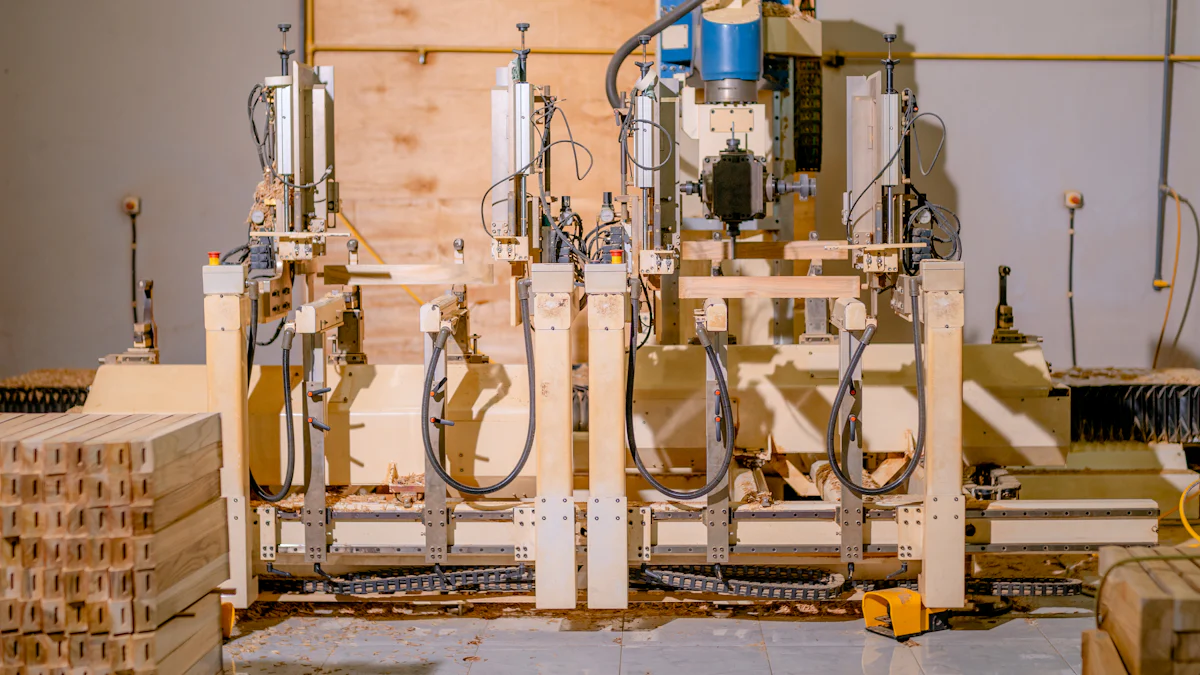
News
A variable frequency drive (VFD) is a game-changer in the world of motor control. It adjusts the speed and torque of electric motors by varying the frequency of the input power. This technology not only enhances energy efficiency but also reduces operational costs. Imagine a conveyor system that becomes 15% more efficient or a pump that cuts energy costs by 20%. That's the power of VFDs. Canroon, a leader in this field, offers innovative solutions like the CV900N high-performance vector frequency inverter and the High Performance Frequency Inverter, including the impressive 750KW Power VFD. These products exemplify the brand's commitment to excellence and efficiency in industrial applications.
 Image Source: pexels
Image Source: pexels
Variable Frequency Drives (VFDs) have revolutionized how industries control motor speed and efficiency. They offer a sophisticated way to manage energy consumption and enhance performance. Let's dive into the mechanics of how these devices operate.
The Working Principle of Variable Frequency Drives
VFDs work by adjusting the frequency and voltage supplied to an electric motor. This adjustment directly influences the motor's speed and torque, allowing for precise control.
Role of Frequency in Motor Speed Control
Frequency plays a crucial role in determining motor speed. By varying the frequency of the electrical power supplied to the motor, VFDs can increase or decrease the motor's speed. This capability allows industries to match motor speed with the specific demands of their applications, leading to improved energy efficiency and reduced mechanical stress. For instance, a conveyor system can become significantly more efficient when its speed is precisely controlled.
Importance of Voltage Regulation
Voltage regulation is another essential aspect of VFD operation. By controlling the voltage, VFDs ensure that motors receive the appropriate power level for their tasks. This regulation helps maintain optimal motor performance and prevents damage from overvoltage or undervoltage conditions. In industrial settings, this means longer motor life and reduced maintenance costs.
How Variable Frequency Drives Control Motor Speed
The control mechanisms within VFDs are both advanced and effective, ensuring precise motor operation.
Pulse Width Modulation (PWM) Technique
One of the key techniques used by VFDs is Pulse Width Modulation (PWM). PWM involves switching the inverter's output on and off at a high frequency to create a variable voltage and frequency supply. This method allows for smooth and efficient motor speed control. The result is a seamless transition between different speeds, which is particularly beneficial in applications requiring frequent speed adjustments.
Feedback Mechanisms for Precision
Feedback mechanisms play a vital role in ensuring precision in VFD operation. These systems continuously monitor motor performance and adjust the VFD's output to maintain the desired speed and torque. This feedback loop enhances system control and ensures that the motor operates efficiently under varying load conditions. In industrial applications, such as those using the 750KW Power VFD, this precision translates to improved product quality and reduced operational costs.
Components and Types of Variable Frequency Drives
 Image Source: pexels
Image Source: pexels
Understanding the components and types of Variable Frequency Drives (VFDs) can help you appreciate their functionality and versatility. Let's break down these elements to see how they contribute to the overall performance of a VFD.
Key Components of a Variable Frequency Drive
A VFD consists of several crucial components that work together to control motor speed and efficiency.
Rectifier
The rectifier is the first stage in a VFD. It converts the incoming AC power into DC power. This conversion is essential because the subsequent stages of the VFD require DC power to function effectively. The rectifier ensures that the VFD can handle varying input voltages and still provide a stable output.
Inverter
The inverter is the heart of the VFD. It takes the DC power from the rectifier and converts it back into AC power with a variable frequency and voltage. This conversion allows the VFD to control the speed and torque of the motor precisely. The CV900N high-performance vector frequency inverter excels in this area, offering advanced vector control for precise motor management.
DC Bus
The DC bus acts as a storage unit within the VFD. It holds the DC power generated by the rectifier before it is converted by the inverter. This component ensures a smooth and continuous power supply to the inverter, which is crucial for maintaining consistent motor performance.
Different Types of Variable Frequency Drives
VFDs come in various types, each suited for specific applications and requirements.
Voltage Source Inverters (VSI)
Voltage Source Inverters are the most common type of VFD. They use a constant DC voltage from the DC bus to produce a variable AC output. VSIs are known for their simplicity and reliability, making them suitable for a wide range of applications.
Current Source Inverters (CSI)
Current Source Inverters differ from VSIs by using a constant DC current. They are typically used in applications requiring high power and torque. CSIs offer robust performance but are less common due to their complexity and cost.
Matrix Converters
Matrix converters represent a more advanced type of VFD. They directly convert AC power to variable AC power without the need for a DC bus. This direct conversion allows for a more compact design and improved efficiency. However, matrix converters are less prevalent due to their complexity and higher cost.
Applications and Benefits of Variable Frequency Drives
Variable Frequency Drives (VFDs) have become essential tools in various industries. They offer numerous applications and benefits that enhance operational efficiency and reduce costs. Let's explore where VFDs shine and why they're so valuable.
Common Applications of Variable Frequency Drives
Industrial Automation
In industrial automation, VFDs play a crucial role. They provide precise control over motor speeds, which optimizes production processes. This fine-tuned control ensures consistent product quality and helps maintain stringent quality standards. For example, conveyor systems benefit greatly from VFDs, as they allow for smooth and efficient operation, reducing wear and tear on equipment.
HVAC Systems
Heating, Ventilation, and Air Conditioning (HVAC) systems rely heavily on VFDs. By adjusting motor speeds, VFDs help regulate airflow and temperature, leading to significant energy savings. They ensure that HVAC systems operate efficiently, reducing energy consumption and lowering utility bills. This makes them an ideal choice for both residential and commercial buildings.
Renewable Energy Systems
VFDs also find applications in renewable energy systems. They optimize the performance of wind turbines and solar panels by controlling the speed of motors and generators. This optimization maximizes energy output and enhances the overall efficiency of renewable energy installations. As a result, VFDs contribute to sustainable energy solutions and help reduce carbon footprints.
Benefits of Using Variable Frequency Drives
Energy Efficiency
One of the most significant benefits of VFDs is their ability to improve energy efficiency. By adjusting motor speeds to match the specific demands of an application, VFDs minimize energy waste. This efficiency translates to lower energy costs and a reduced environmental impact. In many cases, industries see a noticeable decrease in energy consumption, making VFDs a cost-effective investment.
Reduced Mechanical Stress
VFDs help reduce mechanical stress on motors and equipment. By providing smooth acceleration and deceleration, they prevent sudden starts and stops that can cause wear and tear. This gentle handling extends the lifespan of machinery and reduces maintenance needs. Industries benefit from fewer breakdowns and lower repair costs, enhancing overall productivity.
Enhanced Process Control
VFDs offer enhanced process control, allowing for precise adjustments to motor speed and torque. This control proves invaluable in applications requiring exact specifications, such as manufacturing and processing. With VFDs, operators can easily adapt to changing conditions and maintain optimal performance. The High Performance Frequency Inverter, for instance, exemplifies this capability by delivering reliable and efficient motor control.
Practical Considerations for Using Variable Frequency Drives
When it comes to using Variable Frequency Drives (VFDs), a few practical considerations can make all the difference in ensuring optimal performance and longevity. Let's explore some essential tips for installation and maintenance.
Installation Tips
Proper installation of VFDs is crucial for their efficient operation. Here are some key points to consider:
Proper Sizing and Selection
Choosing the right VFD size and type for your application is vital. A VFD that is too small may not handle the load, while one that is too large could lead to unnecessary costs. Technicians from Canroon Electric emphasize the importance of matching the VFD's capacity with the motor's requirements. This ensures that the drive operates efficiently and prolongs its lifespan.
Environmental Considerations
The environment where you install the VFD plays a significant role in its performance. Ensure that the location is free from excessive dust, moisture, and heat. These factors can affect the VFD's operation and lead to premature failure. Control Engineering experts suggest placing VFDs in well-ventilated areas to prevent overheating and ensure reliable performance.
Maintenance and Troubleshooting
Regular maintenance and timely troubleshooting can keep your VFD running smoothly for years. Here's what you need to know:
Regular Inspection and Cleaning
Routine inspections are essential for identifying potential issues before they become major problems. Technicians recommend checking for loose connections, signs of wear, and dust accumulation. Cleaning the VFD regularly helps maintain optimal airflow and prevents overheating. A well-maintained VFD can provide decades of cost-effective service, enhancing operational value.
Common Issues and Solutions
Even with proper maintenance, VFDs may encounter issues. Some common problems include overheating, erratic motor behavior, and communication errors. Canroon Electric technicians advise having a troubleshooting plan in place. This includes checking for error codes, verifying connections, and consulting the manufacturer's guidelines. Reliable technical support can also assist in resolving complex issues, ensuring minimal downtime.
By following these practical considerations, you can maximize the benefits of your VFD investment. Proper installation and maintenance not only enhance performance but also extend the life of your equipment, providing long-term value and efficiency.
Variable Frequency Drives (VFDs) have transformed motor control, offering energy efficiency and cost savings. Canroon's VFDs, like the CV900N High Performance Vector Frequency Inverter, stand out with their precision control and robust design. They cater to diverse industrial needs with features like built-in PID controllers and wide frequency ranges.
FAQs:
Compatibility: Canroon's VFDs integrate seamlessly with various systems.
Cost Considerations: While initial costs vary, the long-term savings in energy and maintenance make them a wise investment.
Please give us a message